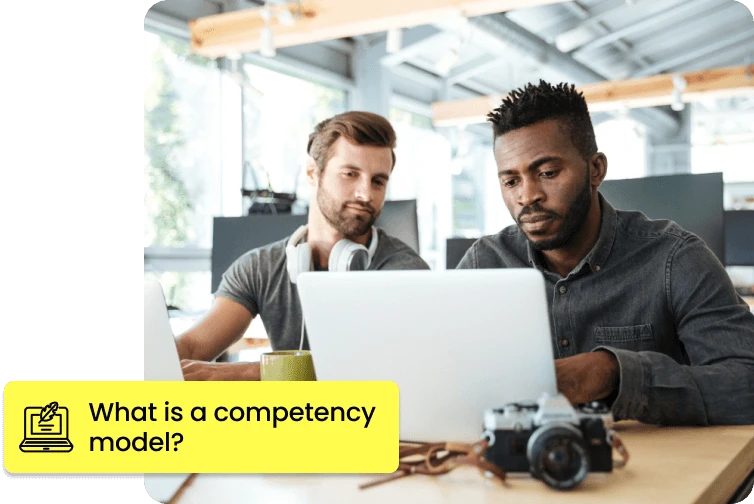Table of Content
Competency models are commonly used in human resources and talent management to guide various HR processes, such as recruitment, performance management, training and development, and succession planning. These models help organizations identify and define the specific competencies that are critical for success in different positions.
A typical competency model includes a set of competencies, which are often categorized into groups or clusters based on their relevance to specific aspects of the job.
Competency models can be dynamic and reflect changes in the organization, industry, or job roles over time. They provide a comprehensive framework for assessing and developing the workforce, aligning individual and organizational goals, and ensuring that employees possess the necessary attributes to excel in their roles.
How is a competency model structured?
A competency model is typically structured with a set of competencies organized into categories or clusters.
The structure may vary based on the organization’s needs, industry, and the specific goals of the competency model.
However, a common structure often includes the following elements:
Core competencies
Fundamental skills and attributes that are essential for success across various roles within the organization.
- Communication skills
- Teamwork
- Adaptability
- Problem-solving
Functional or technical competencies
Specific to a particular job or field, representing the knowledge and skills required for successful performance in that role.
- Programming skills for a software developer
- Financial analysis for an accountant
- Patient care for a healthcare professional
Leadership competencies
Relevant for individuals in managerial or leadership positions, focusing on skills associated with effective leadership.
- Strategic thinking
- Decision-making
- The ability to inspire and motivate others
Behavioral competencies
Observable behaviors and traits that contribute to effective performance.
- Time management
- Attention to detail
- Customer orientation
Personal effectiveness competencies
An individual’s ability to manage oneself and contribute positively to the work environment.
- Self-awareness
- Resilience
- Emotional intelligence
Job-specific competencies
Directly related to the specific requirements of a particular job or role.
- Specific technical skills
- Industry knowledge
- Regulatory compliance expertise
Interpersonal competencies
An individual’s ability to interact effectively with others.
- Communication skills
- Conflict resolution
- Collaboration
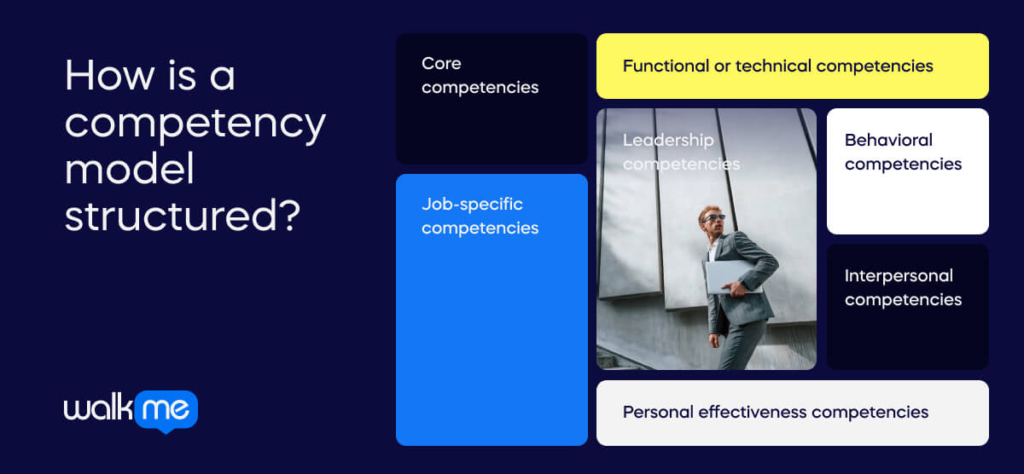
Benefits of using a competency model
Using a competency model in a business or organizational setting offers a range of benefits that can significantly enhance performance, growth, and overall success. Here are some key advantages:
Clear expectations
Employees have clear expectations regarding the knowledge, skills, and behaviors required for success in a particular role.
This clarity helps people to understand what is expected of them, facilitating better performance alignment with organizational goals.
Recruitment and hiring
Those in recruitment can effectively identify and attract candidates with the right skills and attributes for specific roles.
The models provide a basis for creating job descriptions, interviewing, and assessing candidate suitability.
Performance management
Managers have a strong foundation for implementing performance management processes.
They can effectively set performance expectations, conduct meaningful performance reviews, and identify areas for improvement or development.
Training and development
Organizations can target specific competencies for improvement in training and development programmes.
They can ensure that employees receive the necessary training to enhance their skills and capabilities.
McKinsey reports on the importance of capability building, with training results showing that middle managers engaged in deep capability building training reported a 51% increase in core problem-solving competencies.
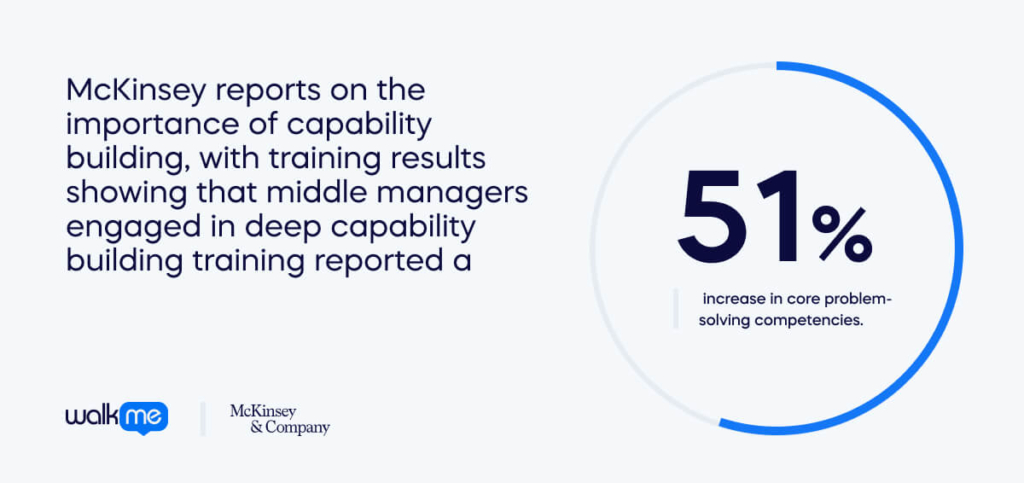
Succession planning
By identifying key competencies required for success in different roles, competency models aid in succession planning.
Organizations can assess and develop internal talent to fill critical positions as they become vacant.
Employee development
A roadmap can be set for individual development plans. Employees can identify areas for improvement, set development goals, and work towards enhancing their competencies, leading to personal and professional growth.
Organizational alignment
Individual performance can be aligned with organizational goals. When competencies are tied to the company’s strategic objectives, employees are more likely to contribute meaningfully to the overall success of the organization.
Communication and feedback
Competency models facilitate communication between employees and managers. They provide a common language for discussing performance, strengths, and areas for improvement, fostering more effective feedback and communication.
Employee engagement
Clear expectations and a focus on individual development contribute to higher levels of employee engagement.
When employees understand how their contributions align with the organization’s goals, they are more likely to feel motivated and engaged in their work.
Continuous improvement
Due to their dynamic nature, competency models can be updated to reflect changes in the business environment, industry trends, or job requirements.
This adaptability allows organizations to stay agile and responsive to evolving needs.
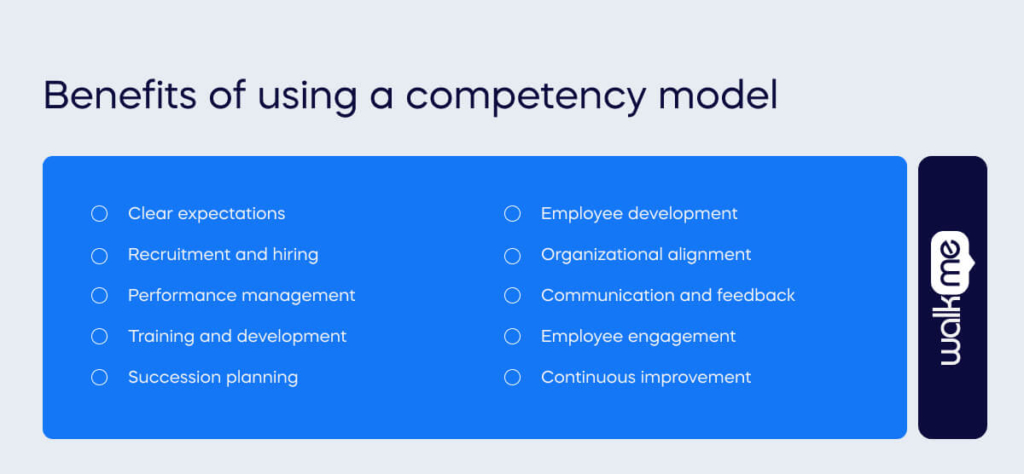
Competency model vs. job specification
| Competency model | Job specification |
| A broader framework that identifies the key knowledge, skills, abilities, and other characteristics required for success. | A more specific document that outlines the qualifications, skills, and requirements for a particular job or role. |
| Typically broader and may apply to multiple roles or positions within an organization. They focus on competencies that are relevant across various functions and levels. | Narrower in scope, concentrating on the specific requirements of a particular job. They provide detailed information about the qualifications and characteristics needed for a specific role. |
| Often used strategically to guide various HR processes across the entire organization. | More tactical and primarily used in the recruitment and selection process. |
| Can be adjusted to reflect changes in the organization’s needs, industry trends, or evolving job roles over time. | Often updated when there are significant changes to the requirements of a specific role. |
| Have a longer-term focus and are part of the organization’s overall talent management strategy. | Often created or revised as needed when a specific job opening arises. |
Competency vs. capability
| Competency | Capability |
| A set of observable and measurable knowledge, skills, abilities, behaviors, and other characteristics that contribute to effective performance in a specific role or job. | The overall capacity and potential of an individual, team, or organization to perform a specific task, function, or set of activities. It is a broader concept that includes a combination of competencies, resources, processes, and strategic alignment. |
| Can encompass a range of attributes, including technical skills, interpersonal skills, problem-solving abilities, communication skills, and more. | Goes beyond individual skills and includes the collective capacity of a group or organization to achieve its goals. This may involve the integration of various competencies, technologies, systems, and processes. |
| Often used in competency models to define the skills and qualities needed for success in various positions within an organization. They guide talent management processes such as recruitment, performance management, training, and development. | Often discussed in the context of organizational capabilities, where the focus is on the combined strengths and resources that enable an organization to deliver value to its stakeholders. It is also relevant in strategic planning and assessing the readiness of an organization to meet its objectives. |
Example of a competency model
Competency models offer a detailed view of the skills and qualities necessary for various roles within organizations, shedding light on both expectations and requirements.
The model for a Customer Service Manager, as an example, specifically highlights the crucial skills and attributes needed for effective leadership in customer service, delineating the key qualities for successfully managing and motivating a customer-centric team.
Core competencies
Communication skills
- Clearly and effectively communicates with customers, team members, and other departments.
- Listens actively to understand customer needs and concerns.
Problem solving
- Identifies and resolves customer issues promptly and effectively.
- Analyzes trends in customer feedback to address root causes of common problems.
Teamwork
- Collaborates with cross-functional teams to improve customer service processes.
- Fosters a positive and collaborative team environment.
Adaptability
- Adapts to changing customer demands and business requirements.
- Embraces new technologies and methodologies to enhance customer service.
Leadership Competencies
Strategic thinking
- Aligns customer service initiatives with overall business goals.
- Develops and executes strategies to enhance customer satisfaction and loyalty.
Decision-making
- Makes informed decisions based on data and customer feedback.
- Demonstrates the ability to make timely decisions to resolve escalated issues.
People management
- Provides constructive feedback to team members for performance improvement.
- Develops and mentors team members to enhance their skills and capabilities.
Conflict resolution
- Effectively resolves conflicts within the team and with customers.
- Promotes a positive and inclusive team culture.
Job-specific competencies
Product knowledge
- Possesses in-depth knowledge of the company’s products and services.
- Stays informed about industry trends and competitor offerings.
Performance metrics
- Monitors and meets key performance indicators (KPIs) related to customer satisfaction.
- Analyzes and interprets performance metrics to drive improvements.
Customer relationship management
- Builds and maintains strong relationships with key customers.
- Develops and implements strategies to retain and upsell to existing customers.
Quality assurance
- Ensures that all customer interactions meet quality standards.
- Conducts regular quality assessments and provides feedback for improvement.
How to develop an effective competency model
Developing an effective competency model involves identifying the critical skills and attributes necessary for success in specific roles within an organization.
It requires a strategic approach to align these competencies with organizational goals and the ever-evolving industry standards. Find the relevant steps below.
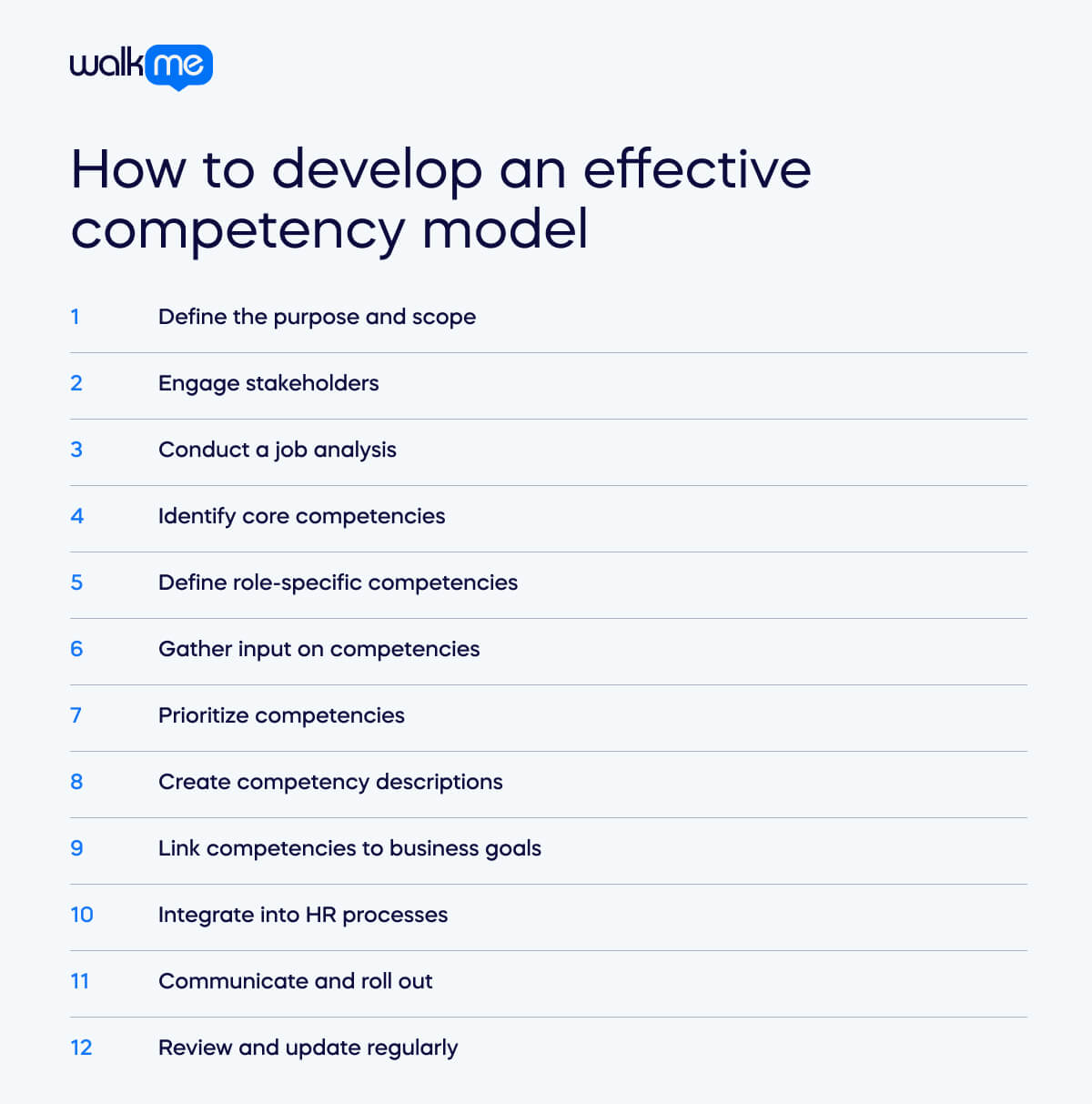
Define the purpose and scope
Clearly articulate why you need a competency model and what goals you aim to achieve. Identify the scope of the model, such as whether it will be organization-wide or specific to certain roles or departments.
Engage stakeholders
Involve key stakeholders, including executives, managers, employees, and HR professionals, in the development process. Their input is crucial for ensuring that the competency model reflects the organization’s values and priorities.
Conduct a job analysis
Perform a thorough job analysis for the roles covered by the competency model. This involves gathering information about the responsibilities, tasks, and skills required for each job. Use methods such as interviews, surveys, and observations.
Identify core competencies
Define the core competencies that are essential across various roles within the organization. These may include generic skills such as communication, teamwork, and problem-solving. Ensure that these strengths align with the organization’s mission and values.
Define role-specific competencies
Identify competencies that are specific to each role. These should reflect the unique skills and attributes required for success in those positions. Consider both technical and behavioral competencies relevant to each role.
Gather input on competencies
Seek feedback from employees who currently hold or have held the targeted roles, as well as from supervisors and managers. This input helps validate and refine the identified competencies.
Prioritize competencies
Prioritize competencies based on their importance and relevance to job success. Some competencies may be essential for all roles, while others may be more role-specific.
Create competency descriptions
Develop clear and concise descriptions for each competency. Clearly define what each competency entails and provide examples of how it is demonstrated in the workplace. This ensures a shared understanding across the organization.
Link competencies to business goals
Align the competencies with the organization’s strategic objectives. This connection reinforces the importance of the competencies in driving the success of the business.
Integrate into HR processes
Incorporate the competency model into various HR processes, including recruitment, performance management, training, and development. Ensure that HR professionals and managers are trained on how to use the model effectively.
Communicate and roll out
Communicate the competency model to employees across the organization. Clearly explain the purpose, benefits, and implications of the model. Provide resources and support to help employees understand and develop the required competencies.
Review and update regularly
Regularly review and update the competency model to ensure its relevance. Changes in the industry, technology, and organizational goals may necessitate adjustments to the model over time.
Last Updated:

